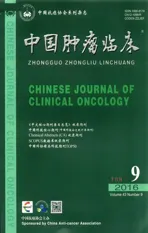STMN1与胃癌的研究进展*
2016-07-14张惠卿柯彬梁寒
张惠卿 柯彬 梁寒
STMN1与胃癌的研究进展*
张惠卿①柯彬②梁寒②
摘要STMN1为微管解聚蛋白,通过磷酸化/去磷酸化调节细胞周期,在细胞增殖分化及肿瘤的发生过程中起重要作用。在白血病及多种实体肿瘤中均有较高表达。目前国内外对STMN1与胃癌关系的研究已初步开展。STMN1的表达对研究胃癌的发生、发展机制及治疗具有一定意义。研究发现STMN1的过表达能够影响某些作用于微管的化疗药物(如多西他赛)的疗效,对指导临床用药有一定的意义。本研究对STMN1在胃癌发生发展中的作用、临床与预后的关系及相关调控通路在胃癌治疗中的作用进行综述。
关键词STMN1胃癌预后
作者单位:①保定市第一中心医院普外科(河北省保定市071000);②天津医科大学肿瘤医院胃部肿瘤科,国家肿瘤临床医学研究中心,天津市肿瘤防治重点实验室
*本文课题受国家自然科学基金(编号:81472744,81401952)和天津市卫生局科技基金(编号:2014KZ082)资助
胃癌是一种起源于胃粘膜上皮细胞的消化道恶性肿瘤,死亡率占所有恶性肿瘤的第二位,其中近一半患者居住于东亚地区[1]。胃癌高致死率的原因是其高侵袭性及高转移性[2-3]。发生在基因及分子层面的改变可以引起胃癌的侵袭转移,影响胃癌的预后。进一步了解相关基因与胃癌的关系对胃癌的诊治及预后研究具有重要的指导意义。
STMN1家族是一类C端螺旋结构域高度保守的磷酸化蛋白,可调控微管的稳定性,该蛋白家族主要包括4个成员:STMN1、SCG10(superior cervical gan⁃glion 10)、SCLIP(SCG10-like protein)和RB3,它们具有共同的结构域(stathmin-like-domain,SLD)[4]。这类磷酸化蛋白被Schubart等[5]发现并命名为STMN1,也称作Stathmin1、p17、p18、p19或op18,是近年来较受关注的蛋白之一[6]。在磷酸化/去磷酸化过程参与下,STMN1通过结合α/β微管蛋白异二聚体发挥解聚微管的生物功能,可以调节有丝分裂期微丝的形态,从而影响纺锤体形成[7];STMN1磷酸化后,下调与微管蛋白异二聚体的结合能力,失去微管解聚活性,从而不能形成有功能的纺锤体。STMN1蛋白在白血病及多种实体肿瘤中,如喉癌[8]、乳腺癌[9]、小细胞肺癌[10]及卵巢癌[11]等均有较高表达。
国内外已就STMN1与结直肠癌等消化道肿瘤的关系开展相关研究[12-14]。STMN1与胃癌关系的研究也已初步展开,其在胃癌的发生、发展、侵袭和转移中均起一定作用,影响疾病预后及后续化疗效果。
1 STMN1 与胃癌发生发展的关系
胃腺上皮癌变是多因素、多阶段的过程,有多种基因参与,研究显示STMN1在胃癌的发生及发展中起相关作用。Phadke等[15]利用双功能短发卡RNA (bifunctional small hairpin RNAs,bi-shRNAs)编码质粒转染肿瘤细胞系,发现经处理后能显著减少体外肿瘤细胞的生长。STMN1过表达在人类实体肿瘤中与不良预后相关。Kang等[16]研究报道,在胃癌细胞系AGS和MKN7中,敲除STMN1后,MTT分析及非贴壁生长单层集落形成实验显示胃癌细胞增殖能力明显降低,细胞侵袭实验也显示同样结果。将STMN1 siRNA转染的SGC-7901细胞和正常胃癌细胞同时种植于同一裸鼠左右腋下,发现STMN1沉默可明显降低肿瘤的生长。张彩凤等[17]利用SGC-7901细胞系进行的动物实验也证实上述结果;并且STMN1 siR⁃NA组Ki-67的染色强度明显低于对照组,细胞增殖指数(17.23%±2.61%)也低于对照组(78.68%± 4.31%)。Liu等[18]研究实验中,STMN1反义脱氧寡核苷酸(antisense oligodeoxynucleotide,ASODN)转染入人胃癌细胞株SGC7901,MTT法显示,转染STMN1 ASODN对胃癌细胞生长有抑制作用。
裸鼠皮下接种人胃癌细胞,待生长至一定大小,分别注射转染了STMN1沉默和非沉默的干扰慢病毒,结果显示,相较注射非沉默STMN1慢病毒的肿瘤,沉默STMN1慢病毒处理的肿瘤大小及重量显著减小。Akhtar等[19-20]系列研究提示,免疫组织化学染色及Western blot检测胃癌MKN-45细胞系,STMN1明显表达;慢病毒载体介导的短发卡RNA转染MKN-45细胞系,细胞侵袭实验和Boyden细胞迁移实验发现,抑制STMN1表达可以显著减少胃癌细胞的体外侵袭及转移能力。动物实验表明,注射STMN1阳性表达瘤细胞的实验裸鼠组较阴性组,肿瘤增长迅速。Jeon等[21]的体外及动物实验也证实,转染慢病毒载体介导的短干扰RNA siRNA后,可有效降低细胞中STMN1表达,从而抑制肿瘤的增殖转移和动物模型中的致瘤性。STMN1的表达对胃癌的发生起关键作用,促进胃癌细胞的增殖及转移。
Ke等[22]利用qRT-PCR及免疫组织化学法分析210例胃癌组织及癌旁正常组织,发现STMN1在mRNA及蛋白表达水平在胃癌组织中均有高表达;Jeon等[21]研究也证实了此结果。
2 STMN1 与临床及预后的关系
Jeon等[21]研究226例韩国胃癌患者(1994年至2003年行手术治疗),STMN1蛋白在胃癌组织中有高表达,其与淋巴结转移、TNM分期及脉管浸润正相关;多因素分析STMN1蛋白与胃癌的无瘤生存期相关。Ke等[22]发现STMN1在胃癌组织中均有高表达;STMN1表达与Lauren分期、肿瘤浸润深度、淋巴结转移、TNM分期相关;与生存时间呈负相关(STMN1阴性与阳性表达的中位生存时间分别为39.6个月和58.2个月),分层分析显示STMN1为Lauren弥漫型癌的独立预后因素。而Batsaikhan等[23]对56例胃癌患者研究显示,STMN1表达只与性别及肿瘤的分化程度相关。STMN1是胃癌的重要预后因子,对评估胃癌患者的生存期有一定参考价值。
3 STMN1 在胃癌中的调控通路及相互作用
表观遗传学可以通过染色质重塑、非编码RNA调控及DNA甲基化参与基因表达调控,形成复杂的调控网络。目前,miRNA对STMN1的调控研究已逐步展开。
Kiga等[24]认为microRNAs可以调节胃腺上皮细胞增殖的能力。实验中发现,在幽门螺旋杆菌(helico⁃bacterpylori,HP)阳性环境中,miR-210基因甲基化,从而导致表达沉默,继而活化STMN1,促进细胞增殖。该研究还推测STMN1在炎症介导的miR-210沉默引发胃癌在内的慢性胃病发病过程中起到重要作用。实验中敲掉胃癌MKN7细胞系的STMN1,细胞增殖、侵袭及转移能力受抑制,细胞停滞在G1期。研究还发现STMN1 为miR-223的下游靶向蛋白。
信号转导因子及转录活化因子3(signal transduc⁃er and signal transducer and activator of transcription 3,STAT3)由STAT3基因编码,可以感受细胞之外的刺激信号,将胞膜上相关因子信号转导至细胞核内,起到调控基因转录的作用。STAT3与Skp2/p27/p21通路相互作用,调节胃癌细胞的侵袭活性。p27蛋白可与α/β微管蛋白竞争,和STMN1相应氨基酸位点结合,影响微管的解聚功能,抑制间充质细胞的移行,而降低p27 kip1的表达,肿瘤细胞侵袭能力增强[25]。胞浆中的STAT3蛋白亦可与stathmin的TBR1/2结构域结合,拮抗stathmin与α/β微管蛋白,抑制stathmin的微管解聚活性[26],通过损害/修复细胞骨架的微管结构,从而影响细胞的侵袭、迁移[27]。STAT3缺失可以抑制细胞侵袭、迁移能力。有研究提示JAK/STAT通路在肿瘤中持续激活,JAK2V617F突变导致STAT3结构磷酸化,并通过STAT3抑制STMN1活性[28]。
同时,有研究报道胃癌中多种细胞因子、癌基因、抑癌基因或酶与STMN1相互作用,如STMN1是活化诱导胞苷脱氨酶(activation-induced cytidine de⁃aminase,AID)、非典型蛋白激酶C(protein kinase C io⁃ta,PKCi)的作用底物[23];与p53表达存在相关性,受其调节[16]。
4 STMN1 与胃癌耐药机制的关系
针对STMN1靶点的抗微管药物,通过促进微管蛋白聚合,抑制解聚,保持微管蛋白稳定,抑制肿瘤细胞有丝分裂,如紫杉醇和多西他赛等,具有聚合和稳定微管的作用,可促使快速增殖的肿瘤细胞被固定于有丝分裂阶段,肿瘤细胞因复制受阻断而凋亡。主要用于治疗晚期乳腺癌、卵巢癌、非小细胞肺癌等。此类药物已应用于胃癌的临床治疗,正进行深入研究。
随着多西他赛在胃癌化疗中的应用,其耐药性引起关注,通过合适的生物标记物预测多西他赛的疗效是临床医师关注的问题。Li等[29]研究提示,叉头盒蛋白M1(forkhead box protein M1,FOXM1)过表达介导多西他赛耐药性。其中STMN1是FOXM1的下游靶点,通过改变微管动力学来对抗多西他赛介导的凋亡;103例胃癌术后标本显示STMN1与FOXM1的相关性。当应用FOXM1抑制剂时,STMN1和FOXM1均下调,耐药性逆转。在Liu等[18]实验中,ST⁃MN1 ASODN增强多西他赛的抗肿瘤作用,显示协同效应,特别提示多西他赛对STMN1阴性的胃癌治疗更加有效。STMN1的表达可为制定治疗计划提供一定依据。
Zhang等[30]的胃癌细胞增殖抑制实验中,新药纳米白蛋白结合型紫杉醇(nanoparticle albumin-bound paclitaxel,nab-paclitaxel)抑制效果优于微米级别的奥沙利铂和表柔比星;动物实验的中位生存时间,纳米白蛋白结合型紫杉醇治疗组优于多西他赛及奥沙利铂组,其机制为肿瘤细胞经纳米白蛋白结合型紫杉醇处理后,STMN1磷酸化表达增加,细胞周期受阻滞于G2/M期,有丝分裂受抑制,肿瘤细胞继而凋亡。纳米白蛋白结合型紫杉醇强大的抗肿瘤活性可应用于肿瘤的抗微管治疗。相关蛋白质组学研究显示[31],STMN1基因沉默可以抑制结直肠癌转移,并且对5-氟尿嘧啶(5-fluorouracil,5-FU)治疗敏感,胃癌中相关研究报道尚不充足。
5 结语
综上所述,STMN1在胃癌的发生、发展和增殖中发挥重要作用。STMN1是胃癌一个新的治疗靶点及可能的预后因子。进一步研究STMN1能有助于针对性地制定化疗方案,以期改善胃癌的预后。
参考文献
[1]Jemal A,Bray F,Center MM,et al.Global cancer statistics[J].CA Cancer J Clin,2011,61(2):69-90.
[2]Steeg PS.Tumor metastasis: mechanistic insights and clinical challenges[J].Nat Med,2006,12(8):895-904.
[3]Huo ZB,Chen SP,Li H,et al.Defining a subgrouptreatable for laparoscopic surgery in poorly differentiated early gastric cancer:the role of lymph node metastasis[J].Cancer Biol Med,2012,9(1):54-56.
[4]Lachkar S,Lebois M,Steinmetz MO,et al.Drosophila stathmins bind tubulin heterodimers with high and variable stoichiometries [J].J Biol Chem,2010,285(15):11667-11680.
[5]Schubart UK.Regulation of protein phosphorylation in hamster insulinoma cells,Identification of Ca2+regulated cytoskeletal and cAMP-regulated cytosolic phosphoproteins by two- dimensional electrophoresis[J].Biol Chem,1982,257(20):12231-12238.
[6]Fuller HR,Slade R,Jovanov-Milosevic NA,et al.Stathmin is enriched in the developing corticospinal tract[J].Molecular and Cellular Neuroscience,2015,69(12):12-21.
[7]Rubin CI,Atweh GF.The role of stathmin in the regulation of the cell cycle[J].J Cell Biochem,2004,93(2):242-250.
[8]Zhang CY,Xiao ZA,Zeng YC,et al.Express of stathmin mRNA and protein in laryngeal squamous cell carcinoma and its clinical implication[J].Chin J Otorhinolaryngol Head Neck Surg,2008,43(4):291-295.[张才云,肖自安,曾益慈,等.Stathmin基因在喉鳞状细胞癌中的表达及临床意义[J].中华耳鼻咽喉头颈外科杂志,2008,43(4): 291-295.]
[9]Alli E,Yang JM,Hait WN.Silencing of stathmin induces tumor-suppressor function in breast cancer cell lines harboring mutant p53 [J].Oncogene,2007,26(7):1003-1012.
[10]Byrne FL,Yang L,Phillips PA,et al.RNAi-mediated stathmin suppression reduces lung metastasis in an orthotopic neuroblastoma mouse model[J].Oncogene,2014,33(7):882-890.
[11]Wei SH,Lin F,Wang X,et al.Prognostic significance of stathmin expression in correlation with metastasis and clinicopathological characteristics in hunman ovarian carcinoma[J].Acta Histochem,2008,110(1):59-65.
[12]Tan HT,Wu W,Ng YZ,et al.Proteomic analysis of colorectal cancer metastasis: stathmin-1 revealed as a player in cancer cell migration and prognostic marker[J].J Proteome Res,2012,11(2):1433-1445.
[13]Liu ZH,Lu HM,Shi HL,et al.PUMA overexpression induces reactive Oxygen species Generation and proteasome- mediated stathmin degradation in colorectal cancer cells[J].Cancer Res,2005,65(5): 1647-1654.
[14]Wang YB,Li SY,An P,et al.Stathmin protein expression in colorectal cancer tissues and its clinical significance[J].Chin J Oper Proc Gen Surg (Electronic Edition),2013,7(4):277-280.[王彦斌,李世拥,安萍,等.stathmin蛋白在结直肠癌组织中的表达及临床意义[J].中华普外科手术学杂志,2013,7(4):277-280.]
[15]Phadke AP,Jay CM,Wang Z,et al.In vivo safety and antitumor efficacy of bifunctional small hairpin RNAs specific for the human stathmin1 oncoprotein[J].DNA Cell Biol,2011,30(9):715-726.
[16]Kang W,Tong JH,Chan AW,et al.Stathmin1 plays oncogenic role and is a target of microRNA- 223 in gastric cancer[J].PLoS One,2012,7(3):e33919.
[17]Zhang CF,Xia YH,Li ZJ,et al.Stathmin siRNA induces growth inhibition and apoptosis of human gastric carcinama SGC-7901 cell xenografts in nude mice[J].Chin J Pathophys,2012,28(7):1253-1256.[张彩凤,夏永华,李贞娟,等.Stathmin siRNA抑制人胃癌SGC-7901细胞裸鼠移植瘤的生长并诱导细胞凋亡[J].中国病理生理杂志,2012,28(7):1253-1256.]
[18]Liu X,Liu H,Liang J,et al.Stathmin is a potential molecular markerand target for the treatment of gastric cancer[J].Int J Clin Exp Med,2015,8(4):6502-6509.
[19]Akhtar J,Wang Z,Zhang ZP,et al.Lentiviral-mediated RNA interference targeting stathmin1 gene in human gastric cancer cells inhibits proliferation in vitro and tumor growth in vivo[J].J Transl Med,2013,11(1):1-9.
[20]Akhtar J,Wang Z,Yu C,et al.Effectiveness of local injection of lentivirus-delivered stathmin1 and stathmin1 shRNA in human gastric cancer xenograft mouse[J].J Gastroenterol Hepatol,2014,29(9): 1685-1691.
[21]Jeon T,Kim JH,Han ME,et al.Overexpression of stathmin1 in the diffuse type of gastric cancer and its roles in proliferation and migration of gastric cancer cells[J].Annals of Oncology,2010,21(6):44.
[22]Ke B,Wu LL,Liu N,et al.Overexpression of stathmin1 is associated with poor prognosis of patients withgastric cancer[J].Tumour Biol,2013,34(5):3137-3145.
[23]Batsaikhan BE,Yoshikawa K,Kurita NA,et al.Expression of stathmin1 in gastric adenocarcinoma[J].Anticancer Res,2014,34(8): 4217-4221.
[24]Kiga K,Mimuro H,Suzuki M,et al.Epigenetic silencing of miR-210 increases the proliferation of gastric epithelium during chronic Helicobacter pylori infection[J].Nat Commun,2014,5(9):4497.
[25]Berton S,Pellizzari I,Fabris L,et al.Genetic characterization of p27 (kip1)and stathmin in controlling cell proliferation in vivo[J].Cell Cycle,2014,13(19):3100-3111.
[26]Verma NK,Dourlat J,Davies AM,et al.STAT3-Stathmin interactions control microtubule dynamics in migrating t-cells[J].J Biol Chem, 2009,284(18):12349-12362.
[27]Wei Z,Jiang X,Qiao HQ,et al.STAT3 interacts with Skp2/p27/p21 pathway to regulate the motility and invasion of gastric cancer cells [J].Cell Signal,2013,25(4):931-938.
[28]Machado-Neto JA,De M,Favaro P,et al.STMN1 inhibition amplifies ruxolitinib-induced apoptosis in STHM1[J].Oncotarget,2015,24(8): 615-625.
[29]Li XX,Yao RY,Yue L,et al.FOXM1 mediates resistance to docetaxel in gastric cancer via up- regulating Stathmin[J].J Cell Mol Med,2014,18(5):811-823.
[30]Zhang C,Awasthi N,Schwarz MA,et al.Superior antitumor activity of nanoparticle albumin-bound paclitaxel in experimental gastric cancer[J].PLoS One,2013,8(2):1-10.
[31]Wu W,Tan XF,Tan HT,et al.Unbiased proteomic and transcript analyses reveal that stathmin-1 silencing inhibits colorectal cancer metastasis and sensitizes to 5- Fluorouracil treatment[J].Molecular Cancer Research,2014,12(12):1717-1728.
(2016-01-22收稿)
(2016-04-05修回)
(编辑:孙喜佳校对:武斌)

Research progress on STMN1 and gastric cancer
Huiqing ZHANG1,Bin KE2,Han LIANG2
Correspondence to: Han Liang;E-mail: tjlianghan@126.com
1Department of General Surgery,The First Central Hospital of Baoding,Baoding 071000,China;2Department of Gastric Cancer,Tianjin Medical University Cancer Institute and Hospital,National Clinical Research Center for Cancer,Tianjin Key Laboratory of Cancer Prevention and Treatment,Tianjin 300060,China
This study was supported by the National Natural Science Foundation of China(No.81472744)and The Youth Project of National Science Foundation of China(No.81401952)and the Scientific Funds of Tianjin Health Bureau(No.2014KZ082)
AbstractSTMN1 is a microtubule-destabilizing protein that regulates cell cycle by phosphorylation and dephosphorylation.It plays an important role in the proliferation and differentiation of cells,in addition to the tumorigenesis.This protein is highly expressed in a wide variety of human cancers,including leukemia and multiple types of solid tumors.The relationship between STMN1 and gastric cancer has recently been investigated.Studying STMN1 in gastric cancer is important.A number of studies have suggested that overexpression of STMN1 can affect the therapeutic response of docetaxel,an anti-microtubule drug.This review summarizes the role of STMN1 in gastric carcinogenesis,development,prognosis,and treatment.The relationship between STMN1 and clinical pathology and its regulation pathways is also investigated.
Keywords:STMN1,gastric cancer,prognosis
doi:10.3969/j.issn.1000-8179.2016.09.083
通信作者:梁寒tjlianghan@126.com
作者简介
张惠卿专业方向为胃肠肿瘤的基础与临床研究。
E-mail:zhang13931386542@sohu.com
·国家基金研究进展综述·
